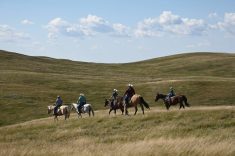Fed cattle prices continue to trend higher as the beef market functions to ration demand. Wholesale beef prices reached the highest level since 2003 with choice product touching $178/cwt. Retail prices are approximately 15 per cent higher than year-ago levels and will likely increase another 10 per cent over the next three to six months. At the same time, consumer at-home food expenditures are up 10 per cent and away-from-home food spending is up 9.5 per cent over year-ago levels.
The increase in the retail price structure will outpace the increase in consumer incomes and expenditures causing U.S. retail movement to slow down during the summer months. This is how a market rations demand.
Read Also

Harvest wraps up and fall work begins
At the Eppich famly ranch in western Saskatchewan, the fall harvest was successful with few breakdowns, cows and calves have been sorted and a new tractor has arrived
Slaughter cattle in Alberta were selling for $108/cwt to $109/cwt in late March while U.S. values in the Southern Plains made new record highs at $118/cwt. Fed cattle prices are up nearly 30 per cent from year-ago levels; packers are short bought and are having to pay up to fulfil nearby requirements. Retailers are also feeling the squeeze of stronger wholesale prices with lower margins. Feeder cattle prices have stayed firm and the recent drop in corn values will enhance U.S. feedlot demand for replacement cattle during the spring period.
EFFECTS OF DOWNSIZING
Cattle on feed in Alberta and Saskatchewan as of March 1 were 948,782 head, down five per cent from March 1, 2010. February feedlot placements were down a whopping 21 per cent and marketings were down 12 per cent in comparison to year-ago levels. We are starting to feel the effects of the lower calf crops as feeder cattle exports are down to a trickle. Canadian beef production will be down from earlier expectations with lighter carcass weights and lower slaughter pace.
U.S. feedlot inventories are expected to run below year-ago levels during the second quarter as placements decline. U.S. auction markets are starting to have sales every second week or once per month due to the lower feeder cattle supplies. Drier conditions in the winter wheat region caused many feeder cattle to be placed sooner than normal. There is now a vacuum of demand for feeder cattle as April placements have potential to be down sharply from last year. Feeder cattle outside feedlots as of January 1 were down 3.3 per cent from January 1, 2010 but placements were still strong in January and February. U.S. feedlot operators are struggling to secure supplies of lightweight cattle that will be marketed in the fourth quarter. Beef production will run above year-ago levels during the first half of 2011 and then drop in the latter half. This should bode well for Canadian exports of live cattle and beef products during the August through December time frame.
EARTHQUAKE IMPACT
The USDA recently raised U.S. beef exports for 2011 to 2.4 billion pounds, up from 2.3 billion pounds in 2010. However, Japan is a leading buyer of U.S. and Canadian beef and the recent earthquake will temper consumption levels. Japanese consumers are now focused on saving money and lower food expenditures will result in softer export demand for North American meat products.
The North American economy is experiencing modest growth. Consumer confidence recently reached up to 70, the highest level since March of 2008. Unemployment is slowly declining, but inflation is a large concern moving forward. Rising energy prices and uncertainty in the Middle East could temper economic expansion and slow consumer spending later in summer.
FEELING UPSIDE
I think we are starting to feel the upside potential in the fed cattle market given the recent price action. When the market starts to move $4/cwt to $6/cwt higher within a week, this is usually a signal of the “panic buy” which can often lead to extreme price moves. Feedlot operators are encouraged to take some protection on 50 per cent of their marketings for the second quarter. This may involve buying some put options or forward contracting a portion of their cattle.
Feeder cattle prices continue to ratchet higher due to strong feedlot margins. U.S. feedlot operators are making $150 to $165 per head and the decline in corn prices has buyers bidding up replacement cattle very aggressively. I’m surprised by the cow slaughter pace which has continued to run very high. Earlier in winter, I thought we would see a decline in cow marketings and increased heifer retention. At this time, the trend of herd liquidation has not changed and feeder supplies will be extremely tight in the latter half of 2011 through 2012.
GeraldKlassenanalysescattleandhogmarkets inWinnipegandalsomaintainsaninterestin thefamilyfeedlotinsouthernAlberta.For commentsorspeakingengagements,hecan bereachedat [email protected] or2042878268
———
Quarter
U.S. Quarterly Beef Production (million pounds)
1
2
3
4
2010
6,251
6,549
6,771
6,746
2011
6,465
6,625
6,665
6,320
Source: USDA, 2011 is USDA estimate.














